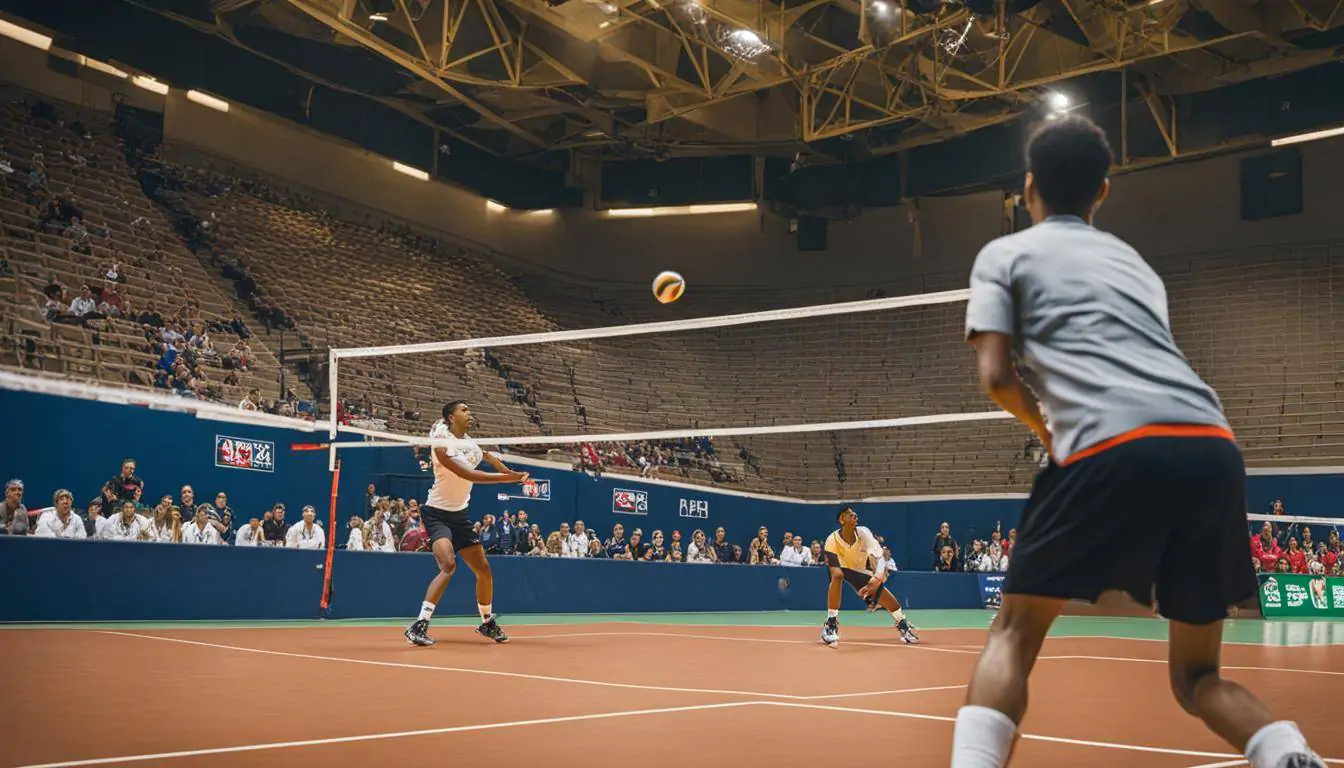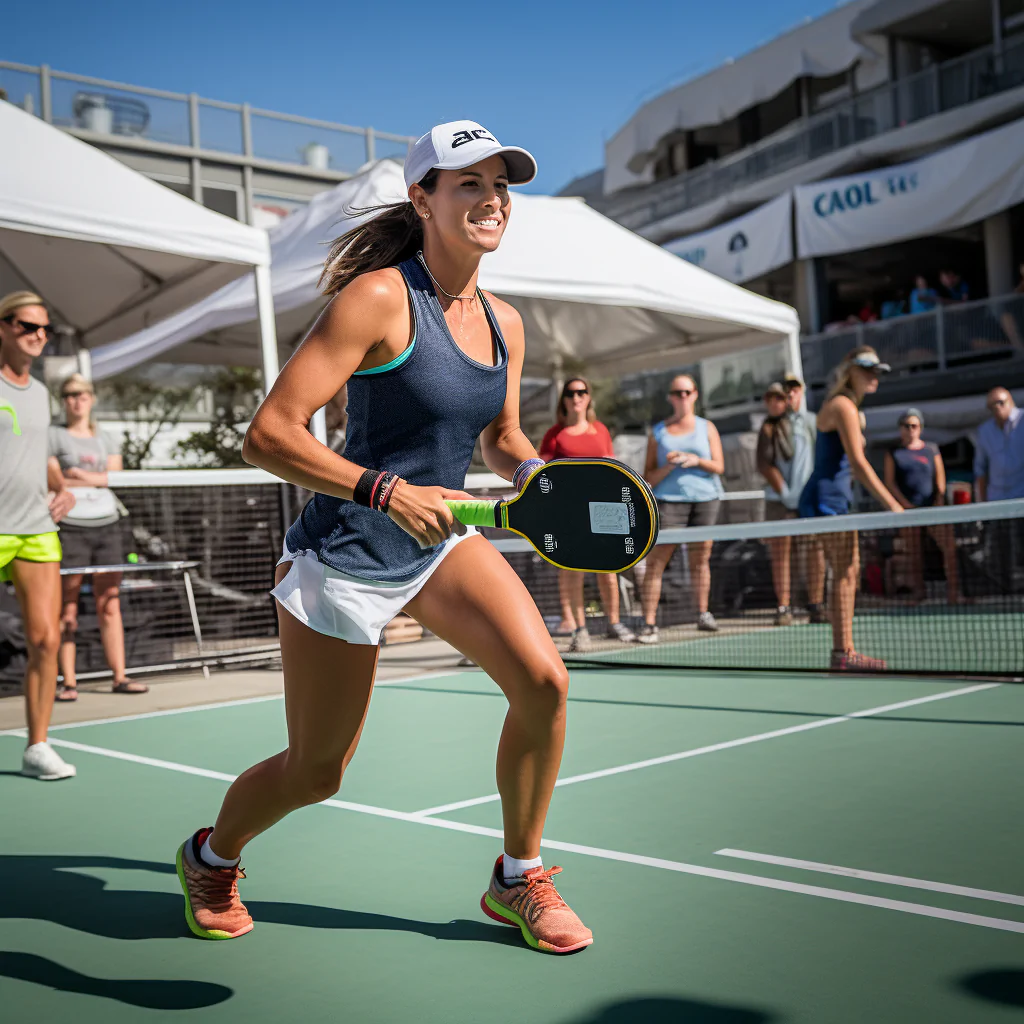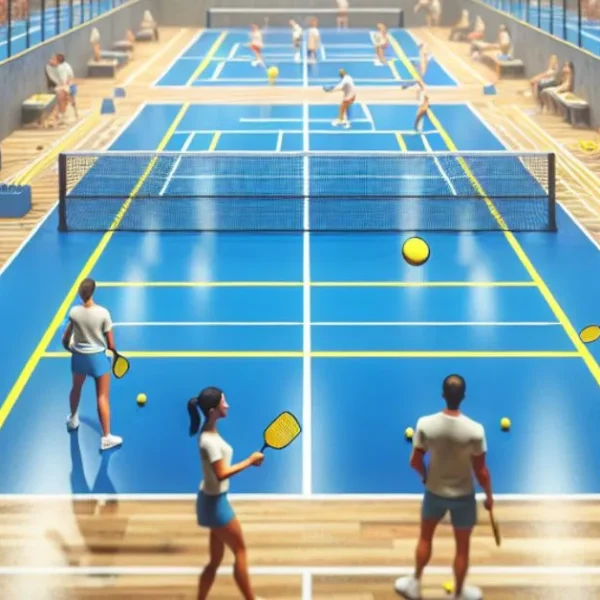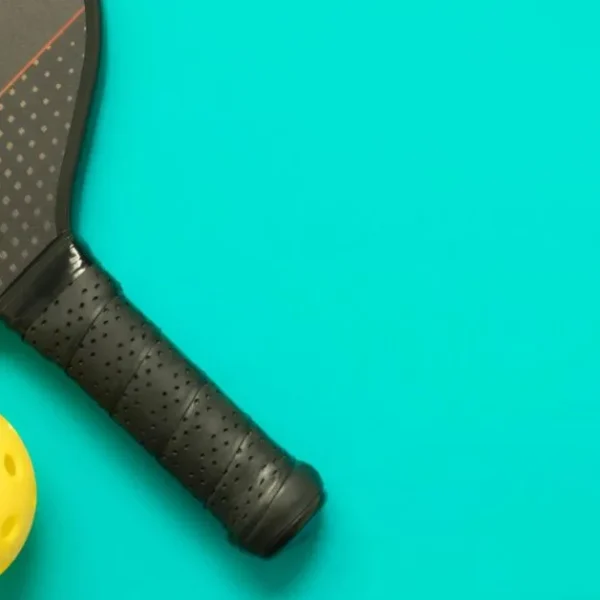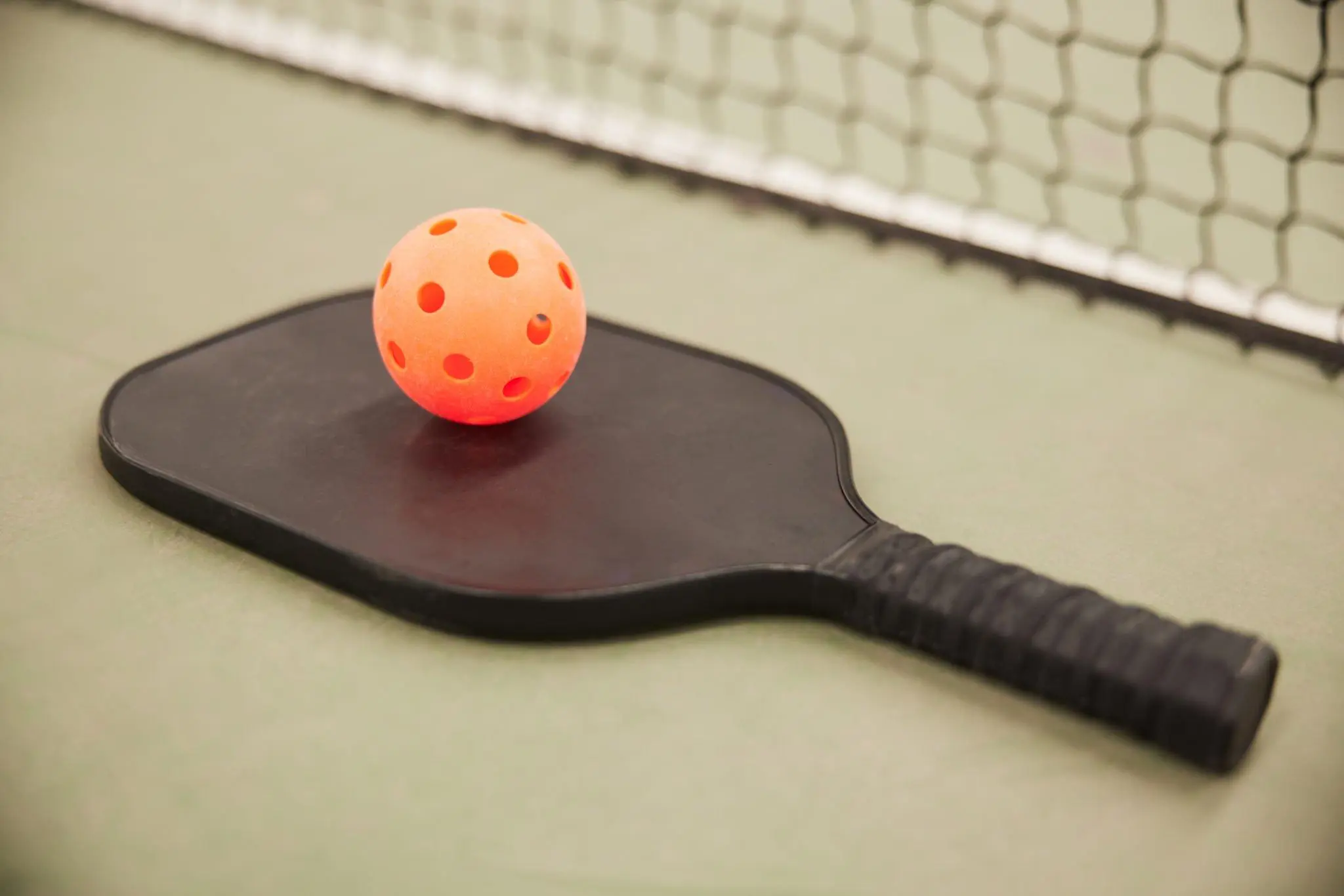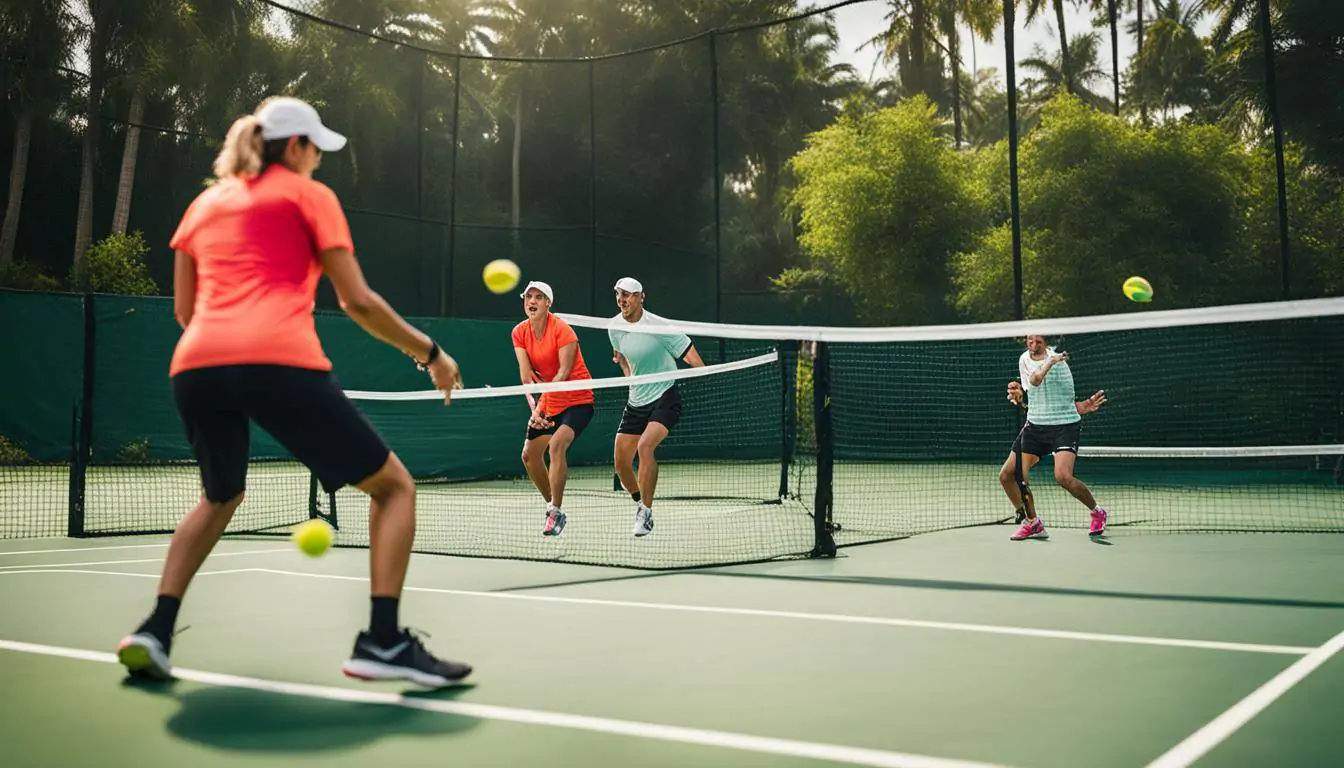Welcome to your comprehensive guide to mastering pickleball singles rules – an essential resource for beginners and experienced players alike. While highly entertaining, pickleball demands a unique set of skills and strategies for singles play, contrasting doubles play where teamwork takes precedence.
By understanding the key elements such as a robust serve and return, strategic movements to the Non-Volley Zone line, and precise shot placement, you’ll have a firm foundation for success in pickleball singles play.
In this article, I will focus on the rules of singles pickleball. Singles pickleball differs from doubles pickleball in that each player only has one serve, and there is no need for the third number in the score for singles pickleball, as there is no concept of server #1 or server #2.
The server serves from the right/even court when his or her score is even and from the left/odd when the score is odd. At the beginning of each new game, only one partner on the serving team has the opportunity to serve before faulting, after which the service passes to the receiving team.
Key Takeaways
- Understand the basics of pickleball singles rules, including scoring and serving.
- Learn the key differences between singles and doubles pickleball play.
- Master the two-bounce rule and the importance of patience and positioning.
- Comprehend serving dynamics and strategies unique to singles play.
- Develop a winning singles strategy by mastering the serve and return game.
- Maintain rally consistency and become well-versed in shot selection.
- Adhere to official pickleball singles rules and address common misunderstandings.
- Skinny single pickleball
Understanding the Basics of Pickleball Singles Rules
To truly grasp the essence of pickleball singles rules, it is essential to appreciate the similarities and differences shared with doubles play. While the fundamental aspects such as rules for serving, Non-Volley Zone, line calls, and faults remain constant in both formats, singles pickleball has unique elements that set it apart. These include the single-service system and the simplified two-number scoring method.
In the forthcoming sections, we aim to provide a practical understanding of the official pickleball rules and dispel common misconceptions to ensure accurate gameplay on the court.
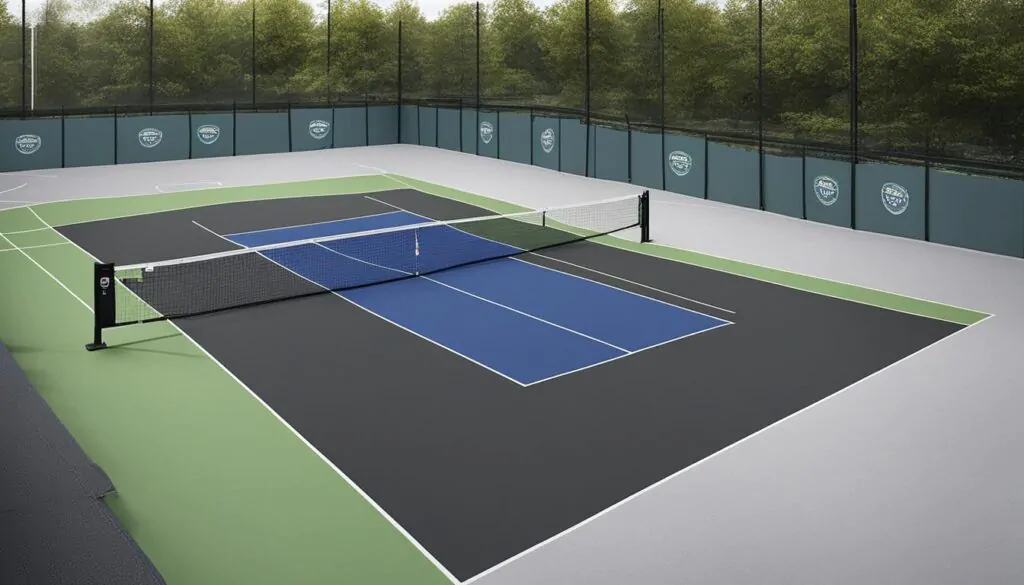
- Single-service system in singles play
- Two-number scoring method
- Importance of strategic movement and positioning
- Impact of endurance and stamina on singles gameplay
By delving deeper into these differentiating factors and understanding the underlying principles, players can better appreciate the complexities of singles play and refine their game strategies accordingly.
| Aspect | Doubles Play | Singles Play |
|---|---|---|
| Serving | Team members are granted two serving opportunities before side out | Player is granted only one serving opportunity before side out |
| Scoring System | Three-number scoring; server’s score, receiver’s score, and serving player number | Two-number scoring; server’s score and receiver’s score only |
| Positioning | Emphasis on teamwork and coordination between partners | Individual responsibility for strategic movements and court coverage |
| Endurance | Shared workload between partners lessens the physical demands | Higher physical demand as players solely manage the entire court coverage |
In conclusion, while the fundamental principles of serving, Non-Volley Zone, line calls, and faults remain constant across both formats, the nuances of singles rules highlight the importance of mastering the individual strategic elements and optimizing physical endurance for success.
Skinny single pickleball
Pickleball has different singles games, including skinny and regular singles. The skinny singles court is only 10 feet wide, which makes hitting the ball more difficult. As with doubles, a regular singles court is the same as a doubles court.
Playing singles in pickleball requires a different strategy than playing doubles. Players must have good footwork, agility, and stamina to cover the court and make quick shots. The importance of passing shots and volleying the ball is crucial for players to be successful in singles.
The Key Differences Between Singles and Doubles Pickleball
While much of the underlying mechanics and rules of singles and doubles pickleball stay the same, there are specific differences that any player should be aware of, both in scoring and strategy. We’ll explore these disparities and highlight ways to incorporate them into your gameplay.
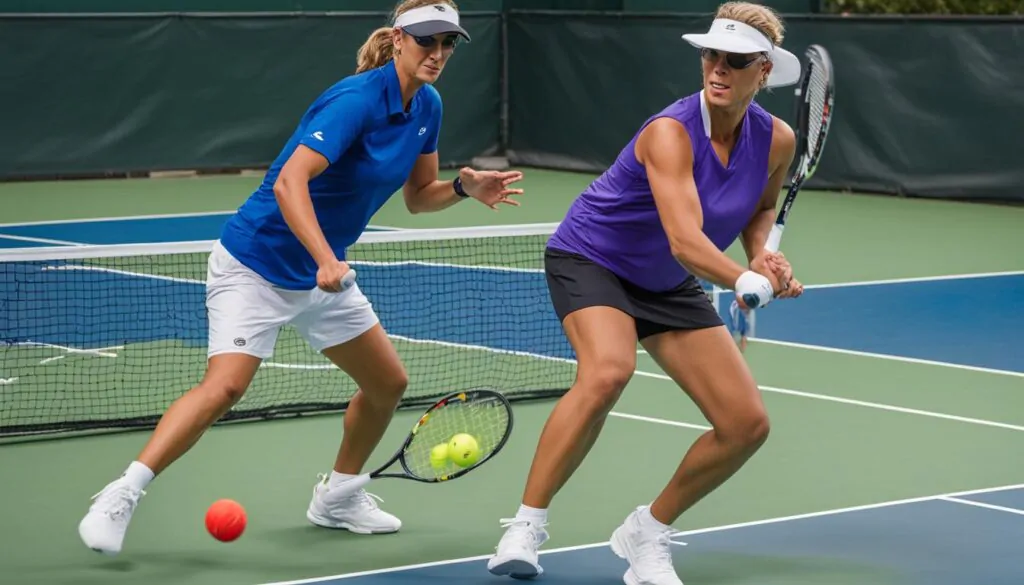
Scoring Nuances in Single Player Mode
The most apparent difference in singles pickleball lies in the absence of the third number in the score, signifying the serving player in doubles play. In singles, the server’s score will always come before the receiver’s score, and each player gets only one opportunity to serve. The scoring is streamlined through a simple two-number system. Let’s take a look at a sample scoring table to illustrate this concept:
| Players | Singles Scoring | Doubles Scoring |
|---|---|---|
| Player A vs. Player B | 4-6 | 4-6-1 |
| Player C vs. Player D | 7-5 | 7-5-2 |
As shown in the table, singles scoring is compact and straightforward, allowing players to focus more on the gameplay than on keeping track of the serving order.
Strategic Positioning Without a Partner
One of the more significant adaptations that singles pickleball demands is a change in player positioning. With no partner to back you up, the ability to govern the court strategically becomes paramount. The primary aspect of this involves serving from the right side when the score is even and the left side when the score is odd. Failing to do so results in a fault, which can have a significant impact on the serve’s legality and potentially the game’s outcome.
Here are some helpful tips for optimal positioning in singles:
- Maintain a central court position to minimize travel distance and facilitate quick reactions.
- Force your opponent to stretch by employing wide shots, lobs, and drop shots.
- Prepare for endurance, as singles play demands more physical fitness and stamina due to increased court coverage.
By understanding and implementing these strategic differences and pickleball scoring nuances, you’ll be well-equipped to step onto the singles court and face the unique challenges it presents.
Navigating the Serve in Singles Pickleball
Mastery of the serve, a critical initial shot, is emphasized in singles play. Comprehending pickleball serve rules and learning how to serve in pickleball is essential for success in singles pickleball serving.
Serving in pickleball must be underhanded, diagonal to the opposing service court, and the server must be confined behind the baseline during the serve. Singles play dictates that serves alternate between the court’s sides based on the server’s even or odd score. To ensure a proper serve, follow these steps:
- Stand behind the baseline, with both feet on the ground.
- Hold the paddle with a relaxed grip.
- Bounce the ball on the ground before serving.
- Perform an underhanded swing, ensuring contact with the ball below the waist.
- Aim the serve diagonally to the opponent’s service court.
| Server’s Score | Serving Side |
|---|---|
| Even | Right |
| Odd | Left |
An effective serve sets the tone for the rest of the rally. Practice different serving techniques such as the topspin serve, slice serve, and flat serve, to keep your opponent guessing and gain an advantage.
It is crucial to maintain a consistent, legal serve throughout the game. Familiarize yourself with common serving faults to avoid losing critical points:
- Hitting the ball above the waist during the serve.
- Stepping on or over the baseline during the serve.
- Failing to serve diagonally across the court.
By mastering the serve in pickleball singles, you are well on your way to becoming a formidable player on the court. Keep practicing and refining your serve technique, and you’ll be well-equipped to challenge opponents and claim victories in singles pickleball matches.
Mastering the Two-Bounce Rule in Singles Play
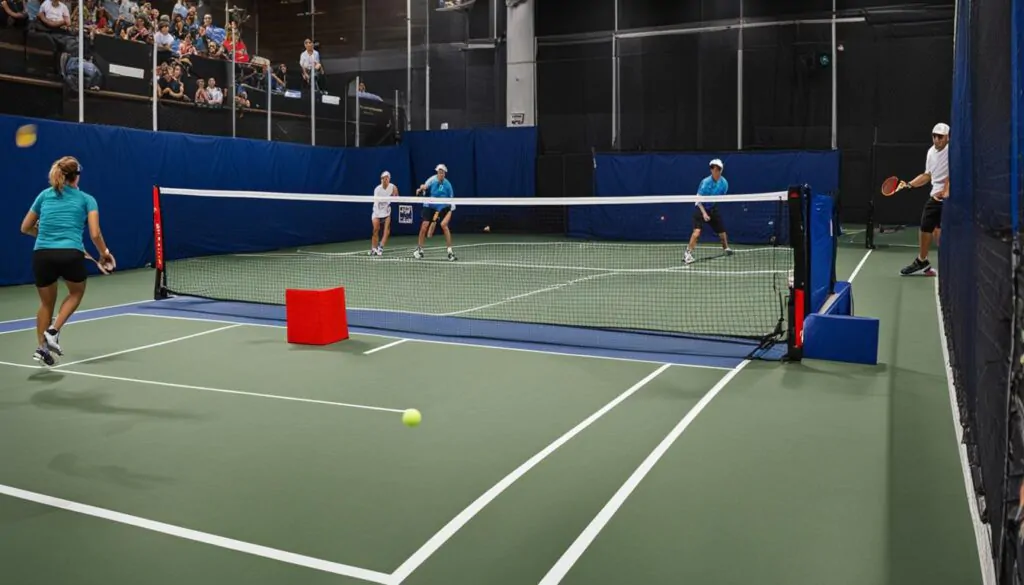
In singles pickleball, understanding the two-bounce rule is crucial for success. Serving as a foundation for basic pickleball rules, the two-bounce rule mandates each team to allow the ball to bounce once on their side before volleying—after the serve return and the subsequent shot by the serving team. This requirement nurtures patience and strategic positioning, as players must shift from rapid volleys to groundstroke-focused exchanges until the rule is satisfied.
The Importance of Patience and Positioning
Patience plays a significant role in adhering to the two-bounce rule, necessitating both the server and the receiver to concentrate on their positioning throughout the play. Learning how to accurately predict the bounce and path of the ball is essential, as well as resisting the urge to volley too soon. Let’s dive into the keys for staying patient and building strong positioning within the two-bounce rule:
- Delay the urge to attack: Suppress your instinct to volley right after the serve return. Instead, focus on proper footwork and ready position, preparing for the second bounce and the start of the response.
- Proactive footwork: Maintain constant motion and stay light on your toes to allow swift and precise movement, ensuring maximum reach and control over the play.
- Optimal shot selection: The two-bounce rule warrants an impeccable shot choice, capitalizing on the opponent’s weaknesses and avoiding risky shots that could leave you vulnerable on the court.
Conclusively, mastering the two-bounce rule in pickleball singles bolsters patient and strategic gameplay, one rooted in proper positioning, footwork, and shot selection. By internalizing and adhering to pickleball rules and regulations surrounding the two-bounce rule, players can enhance their singles performance and overall match success.
Pickleball Non-Volley Zone Commandments
The Non-Volley Zone, also known as ‘the kitchen,’ is a key part of the pickleball court that is governed by specific rules to prevent aggressive net play. In singles matches, understanding the pickleball non-volley zone rules is crucial for maintaining proper gameplay and avoiding faults. This section outlines non-volley zone guidelines, as well as the consequences of violating these rules.
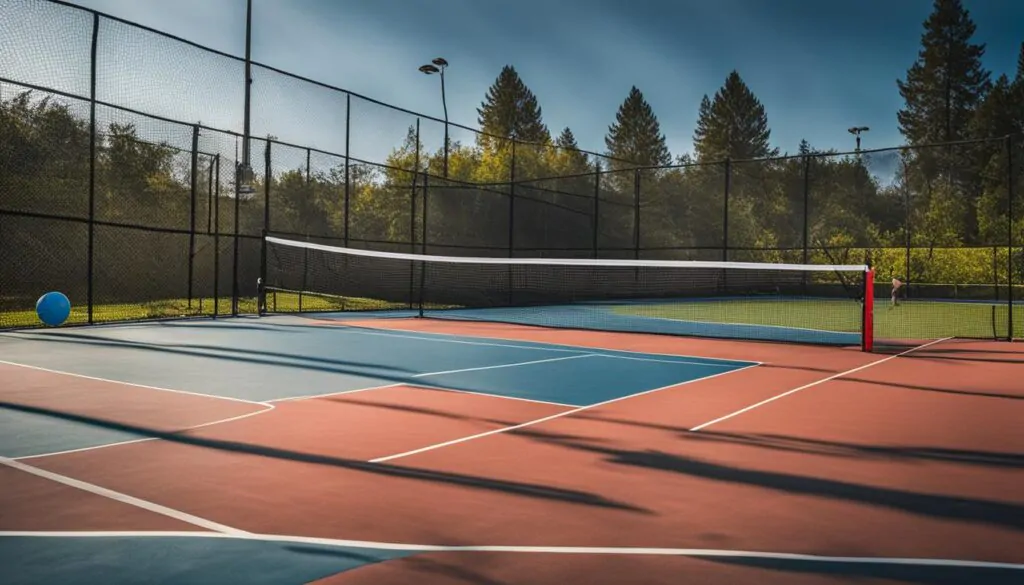
Firstly, the non-volley zone in pickleball refers to the seven-foot area adjacent to the net on both sides of the court. Players are prohibited from volleying, which is hitting the ball without letting it bounce first, while standing within this area or stepping on its lines during a shot. These kitchen rules pickleball mandates are in place to ensure fair and strategic gameplay.
- Volleying is strictly prohibited when standing within the kitchen or stepping on the kitchen lines during the shot.
- Players can step into the kitchen only if the ball has already bounced inside the non-volley zone and they are attempting a groundstroke (a shot after the ball has bounced once).
- Incidental contact with the kitchen lines or area is also considered a fault, especially when the player’s momentum from hitting a volley carries them into the non-volley zone.
Noncompliance with kitchen rules during a singles match results in a fault, which instantly awards the point or serve opportunity to the opponent. Table 1 below lists some of the most common faults and their potential consequences.
| Non-Volley Zone Fault | Consequence |
|---|---|
| Volleying while standing in the kitchen | Loss of point or serve opportunity |
| Stepping on the kitchen lines during a volley | Loss of point or serve opportunity |
| Momentum from volleying carries the player into the kitchen | Loss of point or serve opportunity |
| Incidental contact with the non-volley zone during a volley | Loss of point or serve opportunity |
To maintain proper gameplay and adhere to official pickleball singles rules, it is essential to respect the non-volley zone guidelines and avoid any actions that could lead to a fault. By developing an in-depth understanding of the kitchen rules, players can focus on executing their strategies and positioning on the court—maximizing their chances of securing a win.
Conquering the Court: Optimal Player Positioning
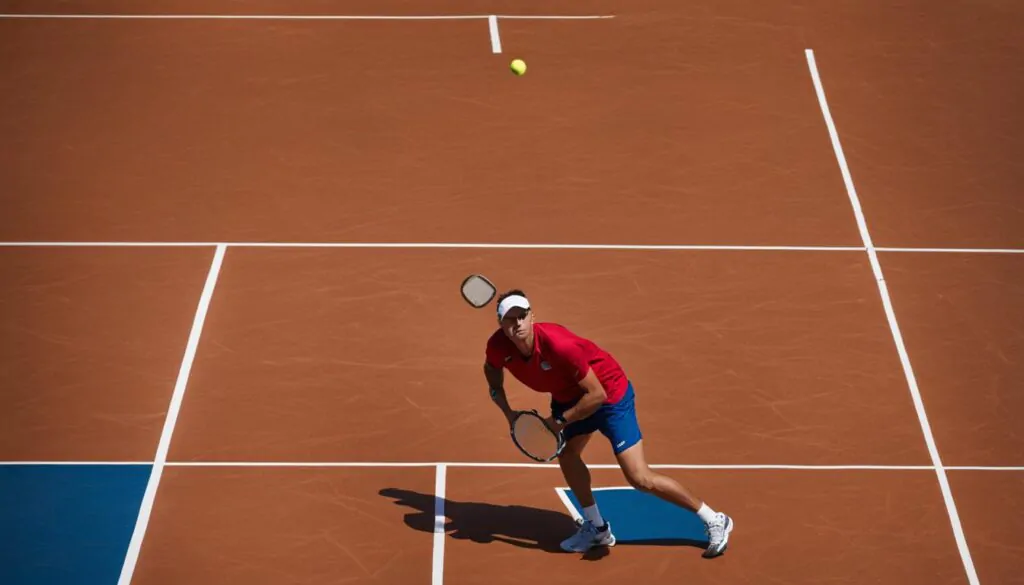
In singles gameplay in pickleball, optimal player positioning is a critical component of success. It is intricately tied to the players’ scores, dictating which side to serve from, and significantly influencing the match outcome. Understanding and implementing accurate positioning during the game will help players avoid common errors, prevent faults, and enhance their chances of winning.
Starting with the Correct Side Based on Score
As the pickleball player positioning relies heavily on the score, it is essential to know where to serve from at any given moment. When a player’s score is even, they must serve from the right-hand side, and when their score is odd, they should serve from the left-hand side. This arrangement is crucial to avoid faults and maintain fair play throughout the match.
- Even scores: serve from the right-hand side
- Odd scores: serve from the left-hand side
Understanding Faults and Avoiding Common Errors
Faults in singles play can occur due to various rule violations, including misplaced serves, prohibited kitchen entries, and incorrect player positioning. As a result, it is vital for players to strategize while prioritizing the adherence to singles gameplay in pickleball rules, to stave off common faults and maximize their opportunities to score.
| Common Singles Fault | Description |
|---|---|
| Misplaced Serves | Serving from the wrong side in accordance with the player’s score – right-hand side for even scores and left-hand side for odd scores. |
| Prohibited Kitchen Entries | Entering the Non-Volley Zone during a volley or stepping on its line, which is against pickleball rules. |
| Incorrect Player Positioning | Failing to maintain accurate player positioning based on the score, consequently leading to faults during serving or gameplay execution. |
Players aiming to excel in pickleball singles must develop a keen understanding of proper positioning and timing to avoid these common pitfalls. By actively prioritizing rule adherence and implementing meticulous strategies, one can successfully conquer the court and outperform their opponents in singles matches.
Crafting a Winning Singles Strategy: Tips and Tactics
In singles pickleball, strategic acumen is essential for dominating the court and emerging victorious. Success relies on several critical aspects such as deep serves, precise control, exploitation of angles, and perfectly timed passing shots. Additionally, endurance training plays a significant role in singles pickleball, given the constant one-yard sprints required throughout the game.
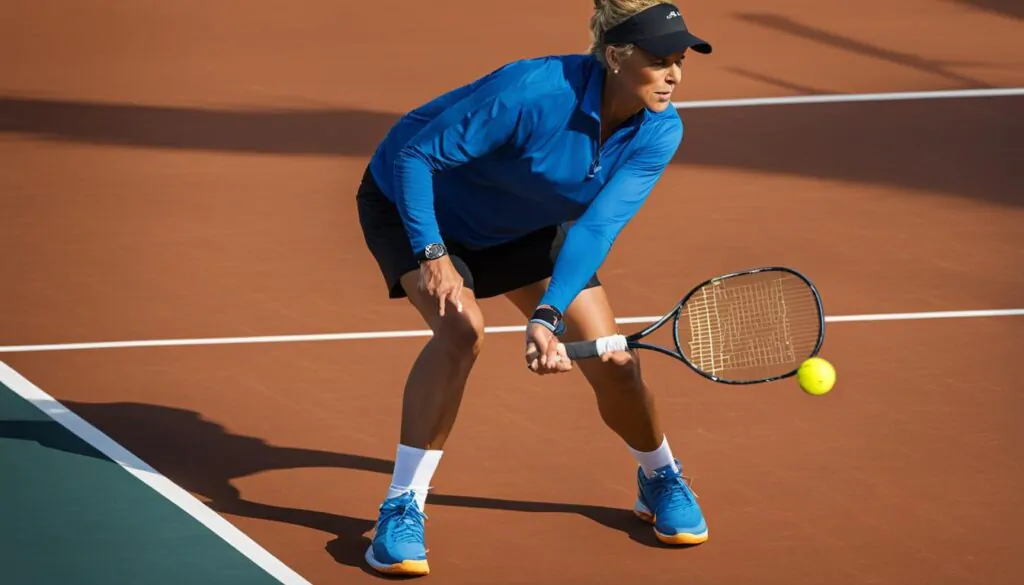
To craft a winning singles strategy, consider incorporating the following tips and tactics into your gameplay:
- Deep serves: Kicking off a singles pickleball game with a powerful and deep serve can facilitate an early advantage while simultaneously mounting pressure on your opponent. By positioning your serve closer to the baseline, you narrow the angles available to your opponent in their return and hamper their ability to control the point.
- Fundamental control: Achieving mastery in basic shot techniques such as groundstrokes, volleys, and overheads creates a strong foundation for singles play. Practice perfecting your technique and implementing strategic shot selection throughout the match to maintain control over the flow of play.
- Exploitation of angles: Successful singles play involves understanding how to use the court’s angles to your advantage. By forcing your opponent into awkward, off-balance positions, you can create space and opportunities for winning points. Pickleball demands quick decision-making and shot positioning to maintain supremacy on the court.
- Passing shots: In singles pickleball, passing shots can be highly effective in catching your opponent off guard. Targeting the open court forces them into challenging, full-stretch retrievals, which can often result in victories. Periodically using passing shots throughout a match keeps your opponent on their toes and helps maintain a sense of unpredictability.
- Endurance training: Engaging in endurance training, such as interval-based sprints or fast-paced agility workouts, prepares you for the physically demanding nature of singles pickleball. Achieving peak fitness enables you to recover quickly and play successive points without losing momentum.
By incorporating these tactics into your singles strategy pickleball plan, you’ll be well-equipped to face opponents with confidence, maximize your potential, and ultimately increase your chances of winning pickleball matches.
Developing Your Pickleball Serve and Return Game
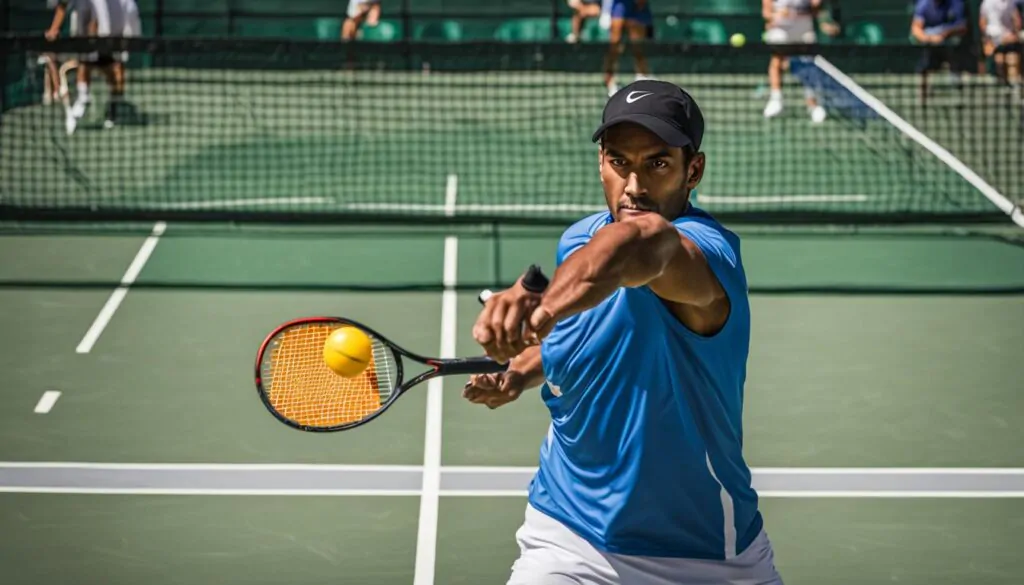
In singles pickleball, perfecting your serve and return game is essential. By capitalizing on each serve and executing a meticulous return, your tactics will shape the match and increase your chances of victory. In this section, we’ll explore strategies to perfect your pickleball serve and return, setting yourself up for success on the court.
Making Every Serve Count
The serve is a prime offensive weapon in singles pickleball. To make every serve count, consider the following singles serve strategies:
- Utilize a big, deep serve to push the opponent back, forcing them to hit upward and giving you the opportunity to approach the net.
- Maintain consistency in your serve, establishing a rhythm that keeps the pressure on your opponent.
- Vary your serve’s speed and spin to keep your opponent guessing, disrupting their timing and precision.
Executing the Perfect Return
Equally critical to the serve, a strategic deep return can provide an extraordinary advantage. Here are some tips to keep in mind when working on your pickleball serve return:
- Strive to hit your returns deep and high, which buys you time to move swiftly to the Non-Volley Zone after service return. This facilitates angle curtailment and marks the outset of offensive positioning.
- Avoid hitting the ball too softly; an aggressive return keeps your opponent on their toes, forcing them to make quick decisions.
- Identify your opponent’s weaker side and target it, exploiting their vulnerabilities.
By perfecting your pickleball serve and honing your return strategies, you will emerge as a formidable singles player. Embrace the tactical challenges that singles pickleball introduces and tackle them head-on to become a force to be reckoned with on the court.
Scoring Dynamics in Pickleball Singles Rules
In pickleball singles rules, scoring dynamics are designed to emphasize the serving player’s advantage and maintain the excitement throughout the game. With games often capped at 11 points, players must strive to attain a 2-point lead margin in order to claim victory. This ensures that matches are not dragged into prolonged, indefinite exchanges, adding to the thrill and intensity of singles play. Let’s delve into the key elements in pickleball scoring dynamics for a better understanding of how they function in singles matches.
Winning by two: A crucial aspect of singles rules scoring is the requirement to win by a 2-point lead. This rule prevents tied games from extending indefinitely and motivates each player to maintain an aggressive and focused approach throughout the match, as every point gained has a significant impact on the outcome.
- Baseline scoring: Pickleball utilizes a two-number scoring system in singles play, which facilitates players in keeping track of their points more easily. When calling out the score, the server announces their points first, followed by the receiver’s points.
- Scoring on serve: The serving player is the only one who can score points, reinforcing the importance of maximizing each serve opportunity. Players are encouraged to capitalize on their serves by employing strategic serves and shot placements that put pressure on their opponents and increase their chances of scoring.
- Point cap: Matches are typically limited to an 11-point cap, demanding players to be more attentive, efficient, and effective in their gameplay. The cap ensures matches remain competitive, motivating players to give their all from start to finish.
Understanding the scoring dynamics in pickleball singles rules helps players strategize and adapt their approach for optimal performance on the court. Familiarity with these dynamics enables players to leverage their serves, recognize scoring opportunities, and minimize the risk of faults, all while enhancing their singles gameplay experience.
Maintaining Rally Consistency and Shot Selection
In the realm of singles pickleball, maintaining rally consistency and thoughtful shot selection is paramount, as it weaves a strategic tapestry that envelops both defensive and offensive capabilities. A well-crafted shot is the cornerstone to dictating the pace of the game, ensuring that you challenge your opponent’s skill and resilience while simultaneously safeguarding your own footing.
Choosing Shots that Dictate the Pace
To maneuver the game as per your discretion, asset these fundamental pointers:
- Select deep serves and returns: Employing deep serves and returns can pressurize your opponent and compel them to make errors. The aim is to place your shots as close to the baseline as possible—restricting their response time and limiting their offensive opportunities.
- Master various shots: By acquiring proficiency in multiple shot types, you can confront diverse situations with poise. For instance, learning the drop shot can help you take an aggressive opponent out of their comfort zone, while a well-timed lob can force your opponent to momentarily disengage from the net.
- Deploy passing shots: When your opponent occupies the Non-Volley Zone, exploit the open court with well-aimed passing shots. These crosscourt or down-the-line shots can confound your opponent’s positioning and garner crucial points.
With practice and insight, your abilities in pickleball shot selection are bound to evolve. Anchor yourself in the wisdom of these strategies while refining your gameplay and watch as your rallies gain consistency and sway on the pickleball court.
Adhering to Official Pickleball Singles Rules
In order to play pickleball singles and maintain the integrity of the game, it is crucial to address common misconceptions and adhere to the official pickleball singles rules. This will help players avoid violating any rules and ensure a fair gameplay experience.
Clearing Up Common Misunderstandings
Several rules often cause confusion among players. Addressing these misconceptions will assist in upholding the integrity of pickleball singles play. Two major points of contention are discussed below:
- Serving: Players often misunderstand the single service system in play. In singles, each player is only granted one serve opportunity before it switches to the other player. Additionally, serving should alternate between the right and left side of the court according to the server’s even or odd score. Misplacement of the serve may result in a fault.
- Non-Volley Zone: Also known as “the kitchen,” players are not allowed to volley from within this zone or touch the lines of the zone during a volley. Committing a non-volley zone violation results in a fault. It is essential to become familiar with the specific boundaries of the kitchen and avoid entering it while volleying.
Learning from Official Sources
To excel in pickleball singles and ensure you are well-versed in the official rules, it is essential to consult authoritative resources. One such resource is the International Federation of Pickleball (IFP) Official Rulebook, which provides a comprehensive repository of regulations and guidelines. Becoming familiar with this rulebook will help you avoid common errors on the court and create strategic gameplay experiences.
| Resource | Description |
|---|---|
| International Federation of Pickleball (IFP) Official Rulebook | A comprehensive guide detailing the official pickleball singles rules, regulations, and guidelines, available on the IFP website. |
| USAPA Pickleball | Provides videos, articles, and resources on pickleball rules and gameplay techniques for singles and doubles. |
| Pickleball Central | Offers a wide range of pickleball resources, including rule clarifications, tips, and strategies for singles play. |
By addressing misconceptions, following official singles rules, and consulting authoritative sources, you can ensure a positive and engaging pickleball singles experience. Mastering these rules will not only improve your gameplay but also allow you to enjoy the sport while upholding its integrity.
Conclusion
Mastering pickleball singles rules is a journey that blends physical prowess with cognitive sharpness, shaping each player into a strategist and athlete. This guide aims to distill the complexity of singles play into actionable insights, preparing players to grace the court with confidence and mastery.
From navigating the serve to understanding scoring dynamics, it’s essential to grasp not only the official rules but also the techniques and strategies that work best in singles play. Through this singles pickleball guide, we’ve provided various insights and information to help you elevate your game while adhering to the rules and avoiding common misunderstandings.
By implementing the knowledge acquired from this comprehensive guide, players will undoubtedly feel prepared to tackle every match with skill, finesse, and most importantly, a deep understanding of pickleball singles rules. With practice and dedication, the journey to becoming an exceptional singles pickleball player is well within reach.
FAQ
What are the key differences between singles and doubles pickleball?
The main differences between singles and doubles pickleball include the single-service system, simplified two-number scoring, and the entire court coverage by a single player in singles play. While serving, Non-Volley Zone, line calls, and fault rules remain constant, singles play emphasizes individual skills and strategy.
How does scoring work in singles pickleball?
Scoring in singles pickleball uses a two-number system, with the server’s score always preceding the receiver’s score. Each player gets just one serving opportunity, and serves alternate between court sides based on the server’s even or odd score. Games often cap at 11 points, with a required 2-point lead margin for victory.
What is the importance of the two-bounce rule in singles play?
The two-bounce rule mandates that each team allows the ball to bounce once before volleying, after the serve and the receiving team’s subsequent shot. This fosters strategic positioning, patience, and more groundstroke-focused exchanges until the rule is satisfied.
How do I maintain proper positioning in singles pickleball?
Proper positioning in singles pickleball matches corresponds with your score. Serve from the right side when your score is even and from the left side when it’s odd. Misplacement results in a fault and can influence the serve’s legality and the match outcome.
What are some tips for developing a winning singles strategy?
To create a winning singles strategy, focus on mastering deep serves, fundamental ball control, exploiting angles, and executing passing shots aimed at the open court. Additionally, improve your endurance and consider the one-yard sprint nature intrinsic to singles pickleball.
Where can I find official pickleball singles rules?
To access official pickleball singles rules, consult the International Federation of Pickleball (IFP) rulebook, which offers a comprehensive repository of regulations and guidelines for both singles and doubles play.
